The Future of Marketing: Social Media for the Australian Auto Industry
VerifiedAdded on 2023/02/01
|7
|1504
|24
Report
AI Summary
This report examines the evolving role of social media marketing within the Australian automobile industry. The research begins by analyzing the business problem, which stems from the increasing prevalence of online users and the subsequent shift towards digital marketing strategies. It explores various research designs, settling on a sequentially explanatory approach combining quantitative and qualitative methods. Key variables and research questions are identified, focusing on the advantages and disadvantages of social media marketing, its impact on the industry, and its effect on profitability. The study also outlines sampling requirements, ethical considerations, and relevant references, providing a comprehensive overview of the research methodology and its application to understanding the dynamic relationship between social media and the automotive sector in Australia. The report also touches upon the impact of the closure of local manufacturing companies and the rise of imported cars, and how social media marketing can help the companies to gain competitive advantage in the market. The research employs a pragmatist view, using different research methods to address different research questions.
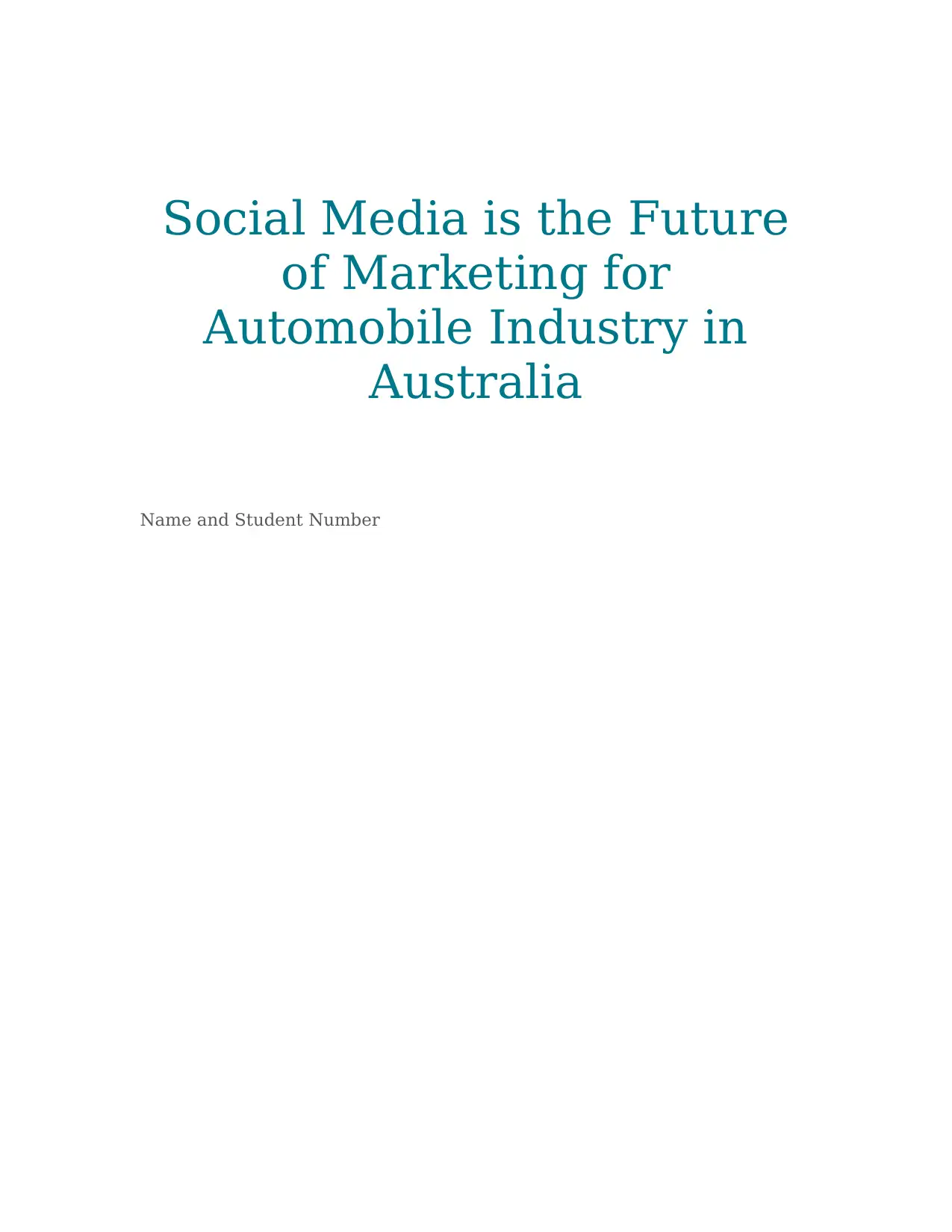
Social Media is the Future
of Marketing for
Automobile Industry in
Australia
Name and Student Number
of Marketing for
Automobile Industry in
Australia
Name and Student Number
Paraphrase This Document
Need a fresh take? Get an instant paraphrase of this document with our AI Paraphraser
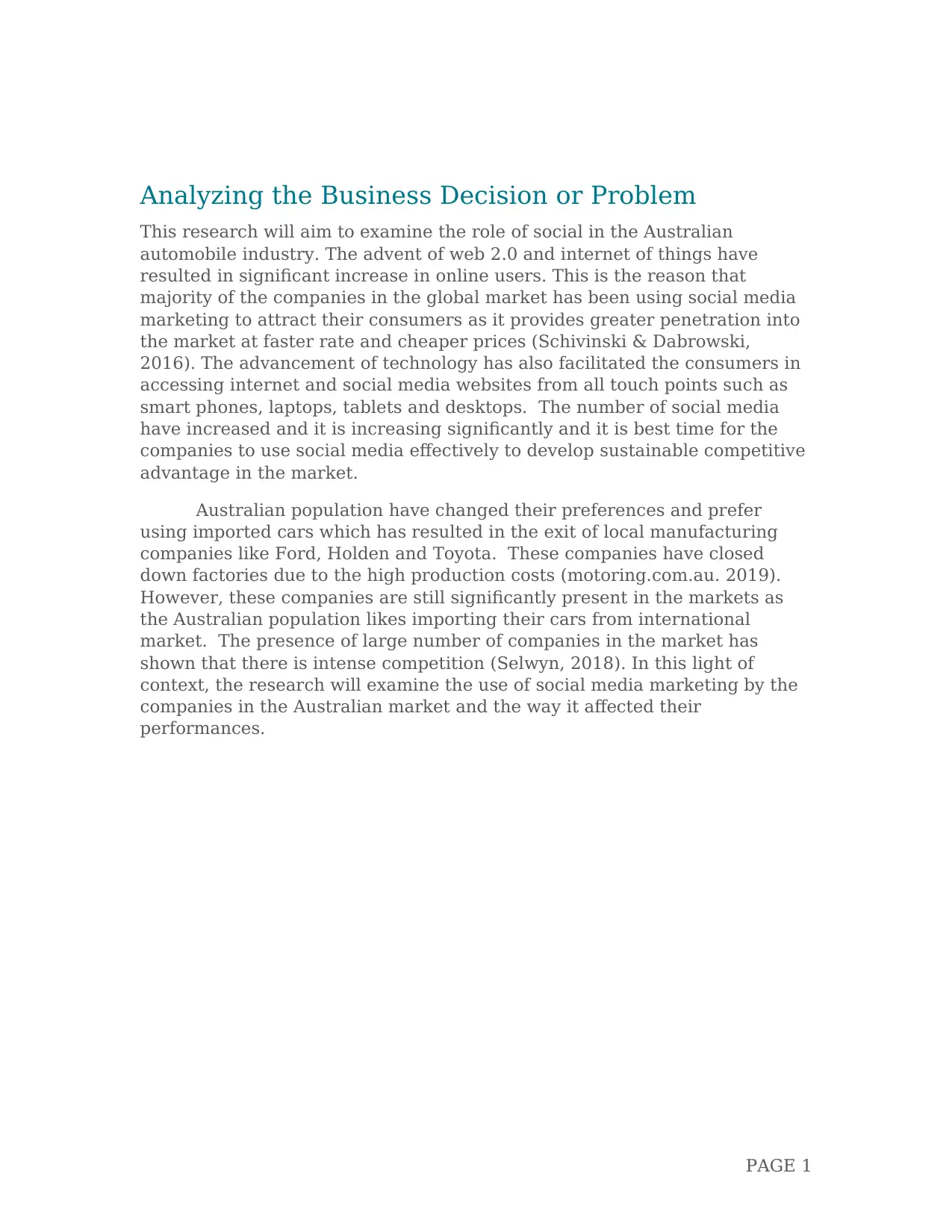
Analyzing the Business Decision or Problem
This research will aim to examine the role of social in the Australian
automobile industry. The advent of web 2.0 and internet of things have
resulted in significant increase in online users. This is the reason that
majority of the companies in the global market has been using social media
marketing to attract their consumers as it provides greater penetration into
the market at faster rate and cheaper prices (Schivinski & Dabrowski,
2016). The advancement of technology has also facilitated the consumers in
accessing internet and social media websites from all touch points such as
smart phones, laptops, tablets and desktops. The number of social media
have increased and it is increasing significantly and it is best time for the
companies to use social media effectively to develop sustainable competitive
advantage in the market.
Australian population have changed their preferences and prefer
using imported cars which has resulted in the exit of local manufacturing
companies like Ford, Holden and Toyota. These companies have closed
down factories due to the high production costs (motoring.com.au. 2019).
However, these companies are still significantly present in the markets as
the Australian population likes importing their cars from international
market. The presence of large number of companies in the market has
shown that there is intense competition (Selwyn, 2018). In this light of
context, the research will examine the use of social media marketing by the
companies in the Australian market and the way it affected their
performances.
PAGE 1
This research will aim to examine the role of social in the Australian
automobile industry. The advent of web 2.0 and internet of things have
resulted in significant increase in online users. This is the reason that
majority of the companies in the global market has been using social media
marketing to attract their consumers as it provides greater penetration into
the market at faster rate and cheaper prices (Schivinski & Dabrowski,
2016). The advancement of technology has also facilitated the consumers in
accessing internet and social media websites from all touch points such as
smart phones, laptops, tablets and desktops. The number of social media
have increased and it is increasing significantly and it is best time for the
companies to use social media effectively to develop sustainable competitive
advantage in the market.
Australian population have changed their preferences and prefer
using imported cars which has resulted in the exit of local manufacturing
companies like Ford, Holden and Toyota. These companies have closed
down factories due to the high production costs (motoring.com.au. 2019).
However, these companies are still significantly present in the markets as
the Australian population likes importing their cars from international
market. The presence of large number of companies in the market has
shown that there is intense competition (Selwyn, 2018). In this light of
context, the research will examine the use of social media marketing by the
companies in the Australian market and the way it affected their
performances.
PAGE 1
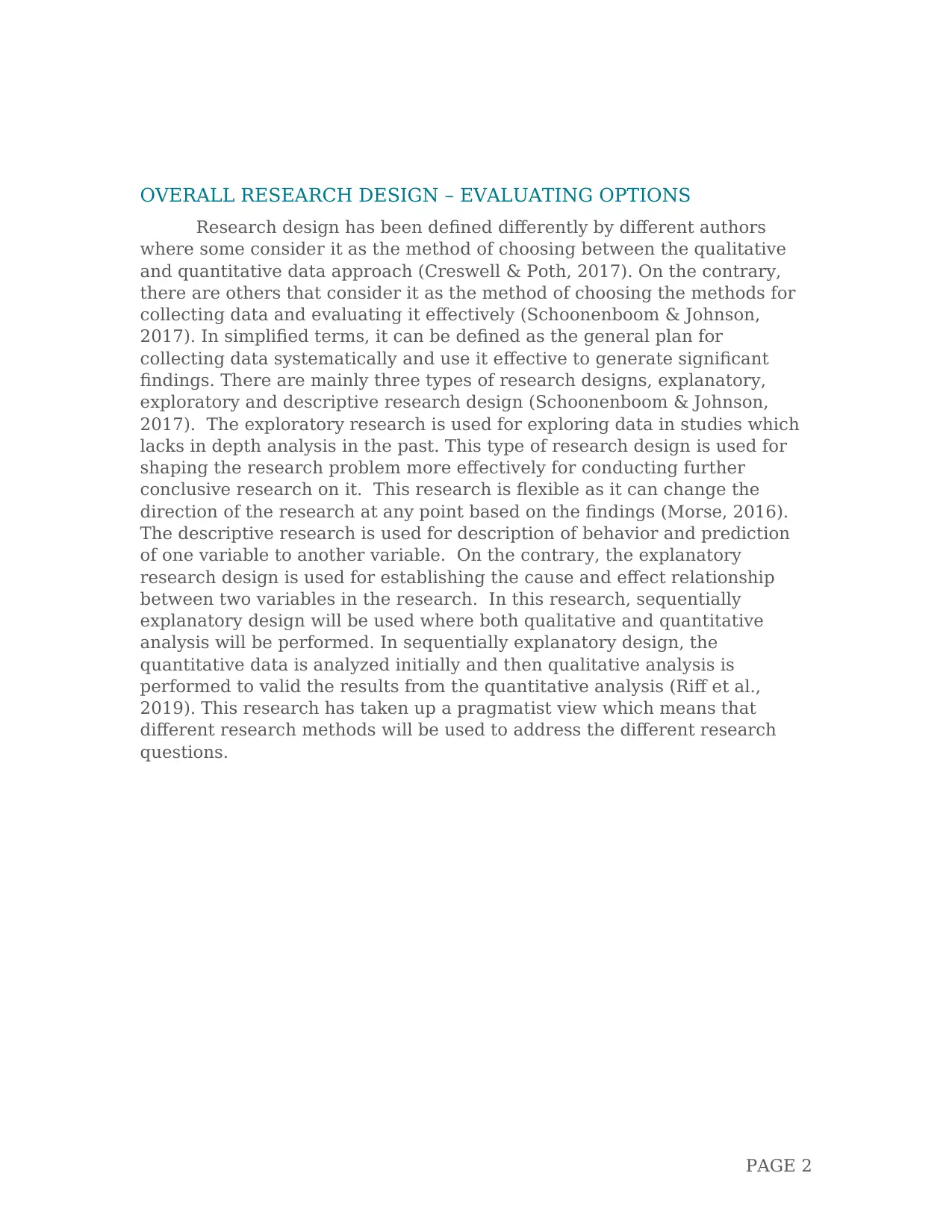
OVERALL RESEARCH DESIGN – EVALUATING OPTIONS
Research design has been defined differently by different authors
where some consider it as the method of choosing between the qualitative
and quantitative data approach (Creswell & Poth, 2017). On the contrary,
there are others that consider it as the method of choosing the methods for
collecting data and evaluating it effectively (Schoonenboom & Johnson,
2017). In simplified terms, it can be defined as the general plan for
collecting data systematically and use it effective to generate significant
findings. There are mainly three types of research designs, explanatory,
exploratory and descriptive research design (Schoonenboom & Johnson,
2017). The exploratory research is used for exploring data in studies which
lacks in depth analysis in the past. This type of research design is used for
shaping the research problem more effectively for conducting further
conclusive research on it. This research is flexible as it can change the
direction of the research at any point based on the findings (Morse, 2016).
The descriptive research is used for description of behavior and prediction
of one variable to another variable. On the contrary, the explanatory
research design is used for establishing the cause and effect relationship
between two variables in the research. In this research, sequentially
explanatory design will be used where both qualitative and quantitative
analysis will be performed. In sequentially explanatory design, the
quantitative data is analyzed initially and then qualitative analysis is
performed to valid the results from the quantitative analysis (Riff et al.,
2019). This research has taken up a pragmatist view which means that
different research methods will be used to address the different research
questions.
PAGE 2
Research design has been defined differently by different authors
where some consider it as the method of choosing between the qualitative
and quantitative data approach (Creswell & Poth, 2017). On the contrary,
there are others that consider it as the method of choosing the methods for
collecting data and evaluating it effectively (Schoonenboom & Johnson,
2017). In simplified terms, it can be defined as the general plan for
collecting data systematically and use it effective to generate significant
findings. There are mainly three types of research designs, explanatory,
exploratory and descriptive research design (Schoonenboom & Johnson,
2017). The exploratory research is used for exploring data in studies which
lacks in depth analysis in the past. This type of research design is used for
shaping the research problem more effectively for conducting further
conclusive research on it. This research is flexible as it can change the
direction of the research at any point based on the findings (Morse, 2016).
The descriptive research is used for description of behavior and prediction
of one variable to another variable. On the contrary, the explanatory
research design is used for establishing the cause and effect relationship
between two variables in the research. In this research, sequentially
explanatory design will be used where both qualitative and quantitative
analysis will be performed. In sequentially explanatory design, the
quantitative data is analyzed initially and then qualitative analysis is
performed to valid the results from the quantitative analysis (Riff et al.,
2019). This research has taken up a pragmatist view which means that
different research methods will be used to address the different research
questions.
PAGE 2
⊘ This is a preview!⊘
Do you want full access?
Subscribe today to unlock all pages.

Trusted by 1+ million students worldwide
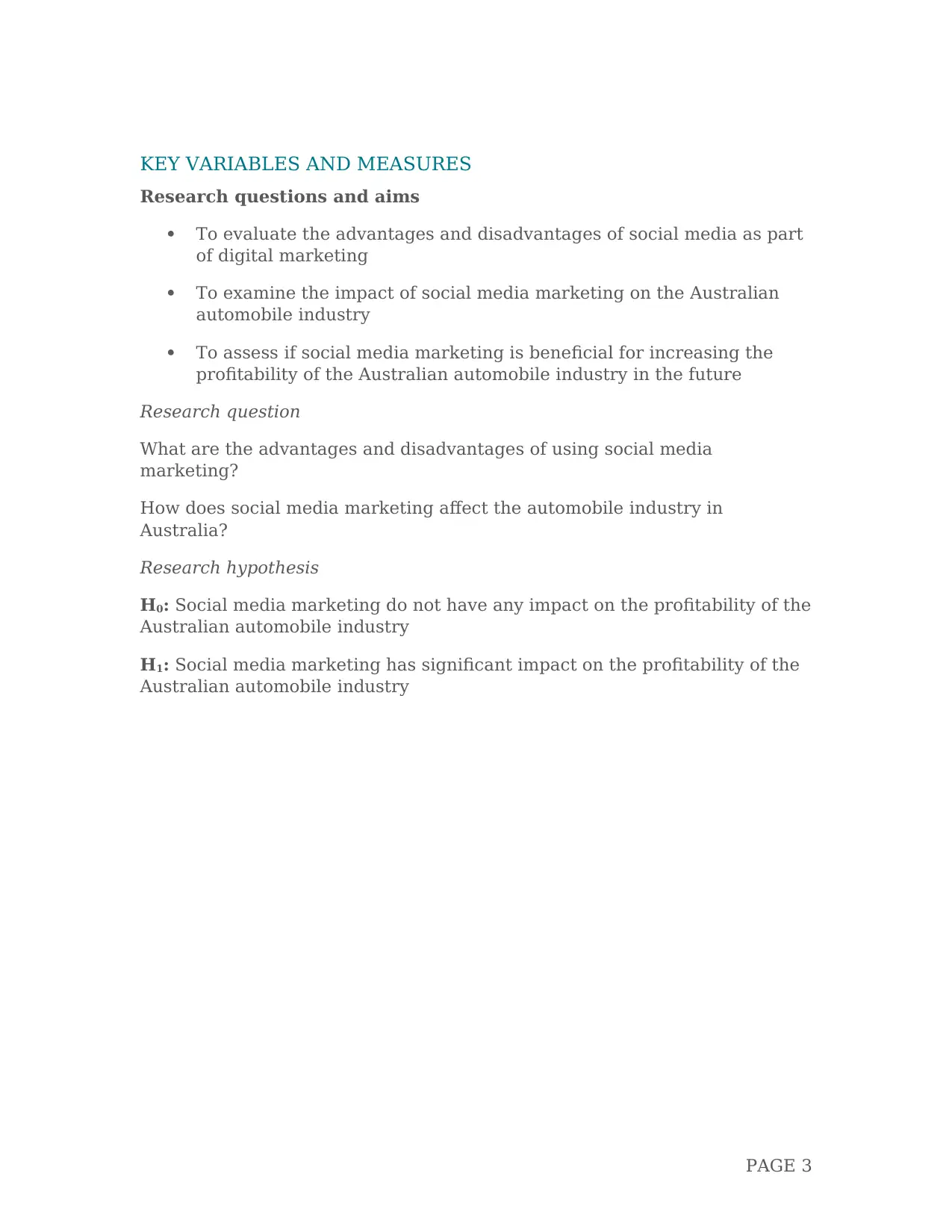
KEY VARIABLES AND MEASURES
Research questions and aims
To evaluate the advantages and disadvantages of social media as part
of digital marketing
To examine the impact of social media marketing on the Australian
automobile industry
To assess if social media marketing is beneficial for increasing the
profitability of the Australian automobile industry in the future
Research question
What are the advantages and disadvantages of using social media
marketing?
How does social media marketing affect the automobile industry in
Australia?
Research hypothesis
H0: Social media marketing do not have any impact on the profitability of the
Australian automobile industry
H1: Social media marketing has significant impact on the profitability of the
Australian automobile industry
PAGE 3
Research questions and aims
To evaluate the advantages and disadvantages of social media as part
of digital marketing
To examine the impact of social media marketing on the Australian
automobile industry
To assess if social media marketing is beneficial for increasing the
profitability of the Australian automobile industry in the future
Research question
What are the advantages and disadvantages of using social media
marketing?
How does social media marketing affect the automobile industry in
Australia?
Research hypothesis
H0: Social media marketing do not have any impact on the profitability of the
Australian automobile industry
H1: Social media marketing has significant impact on the profitability of the
Australian automobile industry
PAGE 3
Paraphrase This Document
Need a fresh take? Get an instant paraphrase of this document with our AI Paraphraser
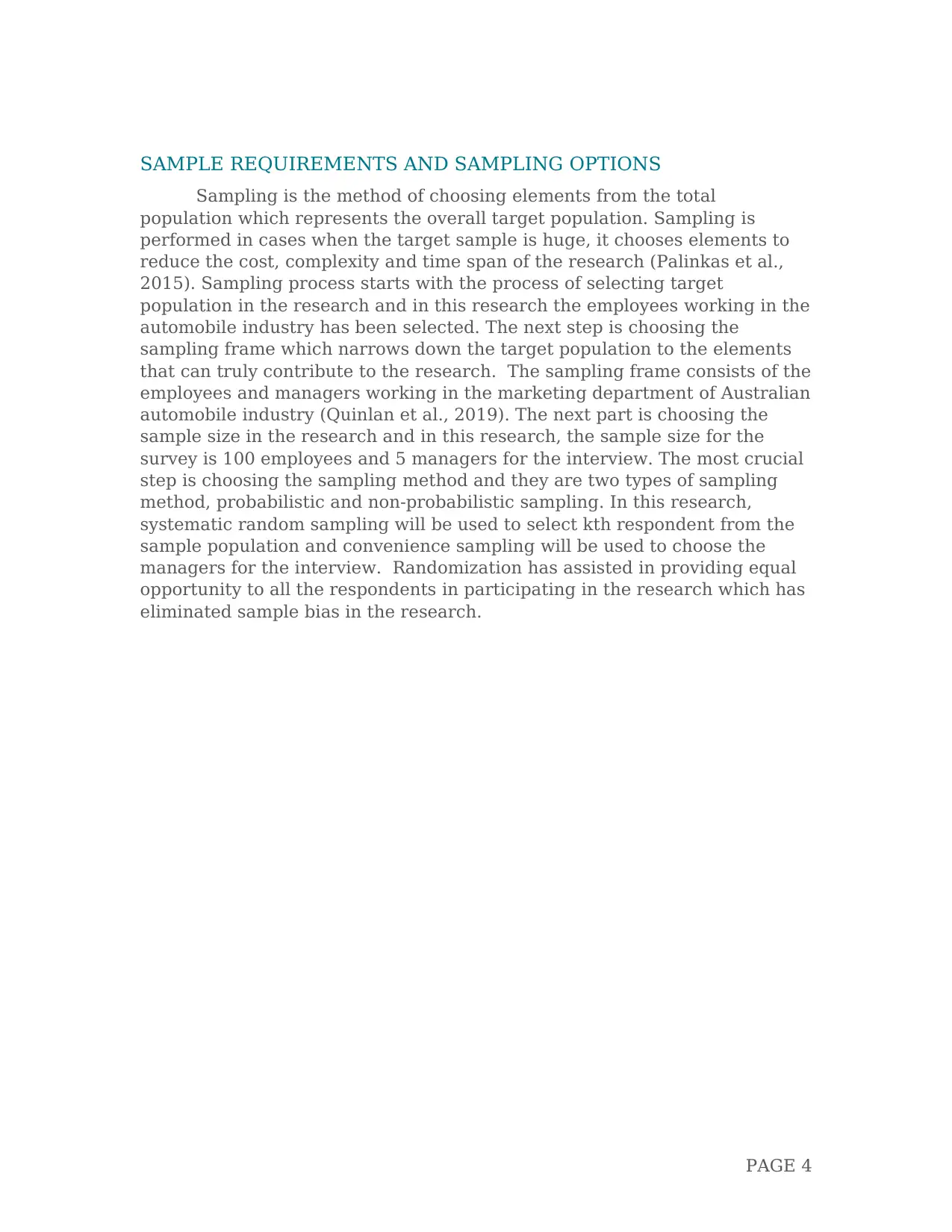
SAMPLE REQUIREMENTS AND SAMPLING OPTIONS
Sampling is the method of choosing elements from the total
population which represents the overall target population. Sampling is
performed in cases when the target sample is huge, it chooses elements to
reduce the cost, complexity and time span of the research (Palinkas et al.,
2015). Sampling process starts with the process of selecting target
population in the research and in this research the employees working in the
automobile industry has been selected. The next step is choosing the
sampling frame which narrows down the target population to the elements
that can truly contribute to the research. The sampling frame consists of the
employees and managers working in the marketing department of Australian
automobile industry (Quinlan et al., 2019). The next part is choosing the
sample size in the research and in this research, the sample size for the
survey is 100 employees and 5 managers for the interview. The most crucial
step is choosing the sampling method and they are two types of sampling
method, probabilistic and non-probabilistic sampling. In this research,
systematic random sampling will be used to select kth respondent from the
sample population and convenience sampling will be used to choose the
managers for the interview. Randomization has assisted in providing equal
opportunity to all the respondents in participating in the research which has
eliminated sample bias in the research.
PAGE 4
Sampling is the method of choosing elements from the total
population which represents the overall target population. Sampling is
performed in cases when the target sample is huge, it chooses elements to
reduce the cost, complexity and time span of the research (Palinkas et al.,
2015). Sampling process starts with the process of selecting target
population in the research and in this research the employees working in the
automobile industry has been selected. The next step is choosing the
sampling frame which narrows down the target population to the elements
that can truly contribute to the research. The sampling frame consists of the
employees and managers working in the marketing department of Australian
automobile industry (Quinlan et al., 2019). The next part is choosing the
sample size in the research and in this research, the sample size for the
survey is 100 employees and 5 managers for the interview. The most crucial
step is choosing the sampling method and they are two types of sampling
method, probabilistic and non-probabilistic sampling. In this research,
systematic random sampling will be used to select kth respondent from the
sample population and convenience sampling will be used to choose the
managers for the interview. Randomization has assisted in providing equal
opportunity to all the respondents in participating in the research which has
eliminated sample bias in the research.
PAGE 4

ETHICAL ISSUES
This research will adhere to all the ethical guidelines mentioned in
different context. This research will protect the privacy of the respondents
by maintaining highest level of anonymity (Walliman, 2017). The data
collected will not be shared and stored securely. The data will be deleted
after the purpose of the research is fulfilled. It is key that respondents
participate voluntarily so informed consent will be developed which will
consist of all information regarding the purpose of the research. The
research will also ensure that plagiarism, fabrication and falsification which
are the three cardinal sins in research will be avoided (Wallace & Sheldon,
2015). This means that works of different authors will be cited accurately
and none of the findings will be manipulated to achieve the given research
objective. It will also make sure that all the data is accurate and has been
taken from trusted sources. This research will not use abusive or
discriminatory language while developing the questionnaire which may
offend the participants or hurt their sentiments.
PAGE 5
This research will adhere to all the ethical guidelines mentioned in
different context. This research will protect the privacy of the respondents
by maintaining highest level of anonymity (Walliman, 2017). The data
collected will not be shared and stored securely. The data will be deleted
after the purpose of the research is fulfilled. It is key that respondents
participate voluntarily so informed consent will be developed which will
consist of all information regarding the purpose of the research. The
research will also ensure that plagiarism, fabrication and falsification which
are the three cardinal sins in research will be avoided (Wallace & Sheldon,
2015). This means that works of different authors will be cited accurately
and none of the findings will be manipulated to achieve the given research
objective. It will also make sure that all the data is accurate and has been
taken from trusted sources. This research will not use abusive or
discriminatory language while developing the questionnaire which may
offend the participants or hurt their sentiments.
PAGE 5
⊘ This is a preview!⊘
Do you want full access?
Subscribe today to unlock all pages.

Trusted by 1+ million students worldwide
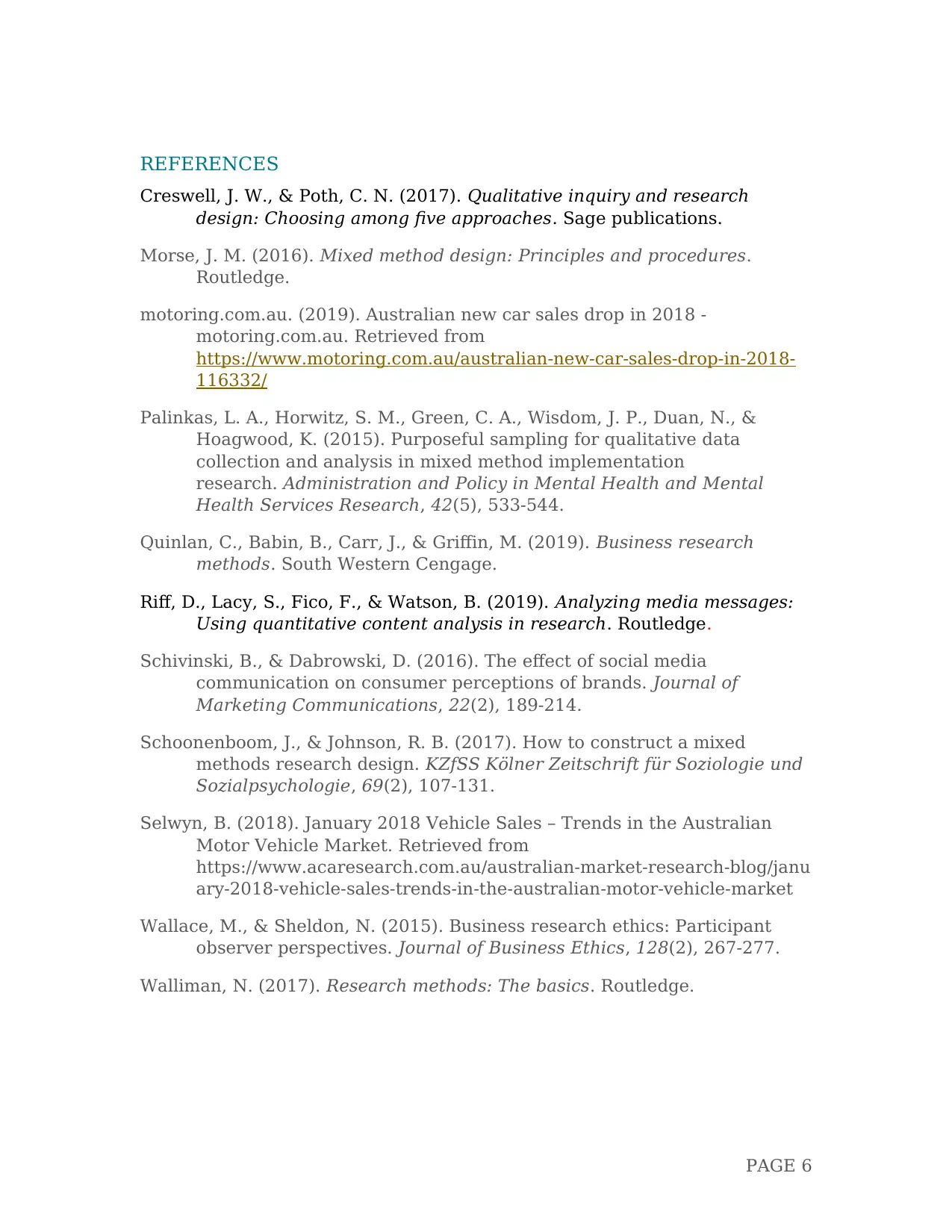
REFERENCES
Creswell, J. W., & Poth, C. N. (2017). Qualitative inquiry and research
design: Choosing among five approaches. Sage publications.
Morse, J. M. (2016). Mixed method design: Principles and procedures.
Routledge.
motoring.com.au. (2019). Australian new car sales drop in 2018 -
motoring.com.au. Retrieved from
https://www.motoring.com.au/australian-new-car-sales-drop-in-2018-
116332/
Palinkas, L. A., Horwitz, S. M., Green, C. A., Wisdom, J. P., Duan, N., &
Hoagwood, K. (2015). Purposeful sampling for qualitative data
collection and analysis in mixed method implementation
research. Administration and Policy in Mental Health and Mental
Health Services Research, 42(5), 533-544.
Quinlan, C., Babin, B., Carr, J., & Griffin, M. (2019). Business research
methods. South Western Cengage.
Riff, D., Lacy, S., Fico, F., & Watson, B. (2019). Analyzing media messages:
Using quantitative content analysis in research. Routledge.
Schivinski, B., & Dabrowski, D. (2016). The effect of social media
communication on consumer perceptions of brands. Journal of
Marketing Communications, 22(2), 189-214.
Schoonenboom, J., & Johnson, R. B. (2017). How to construct a mixed
methods research design. KZfSS Kölner Zeitschrift für Soziologie und
Sozialpsychologie, 69(2), 107-131.
Selwyn, B. (2018). January 2018 Vehicle Sales – Trends in the Australian
Motor Vehicle Market. Retrieved from
https://www.acaresearch.com.au/australian-market-research-blog/janu
ary-2018-vehicle-sales-trends-in-the-australian-motor-vehicle-market
Wallace, M., & Sheldon, N. (2015). Business research ethics: Participant
observer perspectives. Journal of Business Ethics, 128(2), 267-277.
Walliman, N. (2017). Research methods: The basics. Routledge.
PAGE 6
Creswell, J. W., & Poth, C. N. (2017). Qualitative inquiry and research
design: Choosing among five approaches. Sage publications.
Morse, J. M. (2016). Mixed method design: Principles and procedures.
Routledge.
motoring.com.au. (2019). Australian new car sales drop in 2018 -
motoring.com.au. Retrieved from
https://www.motoring.com.au/australian-new-car-sales-drop-in-2018-
116332/
Palinkas, L. A., Horwitz, S. M., Green, C. A., Wisdom, J. P., Duan, N., &
Hoagwood, K. (2015). Purposeful sampling for qualitative data
collection and analysis in mixed method implementation
research. Administration and Policy in Mental Health and Mental
Health Services Research, 42(5), 533-544.
Quinlan, C., Babin, B., Carr, J., & Griffin, M. (2019). Business research
methods. South Western Cengage.
Riff, D., Lacy, S., Fico, F., & Watson, B. (2019). Analyzing media messages:
Using quantitative content analysis in research. Routledge.
Schivinski, B., & Dabrowski, D. (2016). The effect of social media
communication on consumer perceptions of brands. Journal of
Marketing Communications, 22(2), 189-214.
Schoonenboom, J., & Johnson, R. B. (2017). How to construct a mixed
methods research design. KZfSS Kölner Zeitschrift für Soziologie und
Sozialpsychologie, 69(2), 107-131.
Selwyn, B. (2018). January 2018 Vehicle Sales – Trends in the Australian
Motor Vehicle Market. Retrieved from
https://www.acaresearch.com.au/australian-market-research-blog/janu
ary-2018-vehicle-sales-trends-in-the-australian-motor-vehicle-market
Wallace, M., & Sheldon, N. (2015). Business research ethics: Participant
observer perspectives. Journal of Business Ethics, 128(2), 267-277.
Walliman, N. (2017). Research methods: The basics. Routledge.
PAGE 6
1 out of 7
Related Documents
Your All-in-One AI-Powered Toolkit for Academic Success.
+13062052269
info@desklib.com
Available 24*7 on WhatsApp / Email
![[object Object]](/_next/static/media/star-bottom.7253800d.svg)
Unlock your academic potential
Copyright © 2020–2025 A2Z Services. All Rights Reserved. Developed and managed by ZUCOL.





